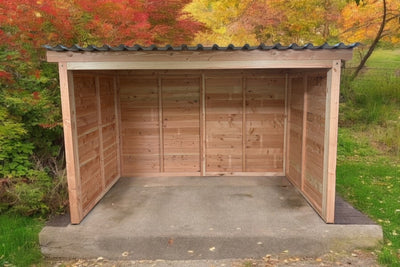Wooden shelters as part of a sustainable garden design

Sustainability is increasingly becoming a central theme in garden design. The desire to use environmentally friendly materials and techniques is increasingly shaping the decisions we make when designing our gardens. A wooden shelter can play an important role in this by not only providing practical benefits but also contributing to the sustainable use of resources. In this article, you will learn how wooden shelters can be used as part of a sustainable garden design and what benefits they offer.
Use of sustainable materials
Wood is a naturally renewable resource which, when sourced sustainably, is an excellent choice for environmentally conscious garden lovers. Choosing the right wood and the right treatment can extend the life of a wooden shelter while minimizing its environmental impact.
- Certified wood: Make sure the wood for your shelter comes from sustainably managed forests, preferably certified by seals such as FSC (Forest Stewardship Council) or PEFC (Program for the Endorsement of Forest Certification). These certificates ensure that the wood has been produced in an environmentally friendly way.
- Natural wood preservatives: Use environmentally friendly wood preservatives based on natural oils and waxes to protect the wood from the weather without harming the environment.
Promotion of biodiversity

A wooden shelter can be more than just a storage space - it can also help to promote biodiversity in your garden. By integrating plants and natural elements, you can transform the shelter into a small ecosystem.
- Green roofs: Consider adding a green roof to your wooden shelter. This provides a habitat for insects and promotes biodiversity in your garden. Green roofs also improve insulation and help reduce rainwater runoff.
- Insect hotels and nesting boxes: Incorporate insect hotels or nesting boxes in or around your wooden shelter to provide shelter for bees, butterflies and birds. These small habitats support pollination and natural pest infestation in the garden.
Energy-saving design
Wood shelters can also help to save energy, especially if they are used to store firewood. A well-stored wood supply can reduce the need for fossil fuels and thus improve your household's carbon footprint.
- Efficient firewood storage: By storing firewood properly in a well-ventilated wood shelter, you can reduce the drying time of the wood and maximize its calorific value. Dry wood burns more efficiently and produces less smoke and pollutants.
- Solar roofs: If the location and orientation of the shelter allows, you could install a solar roof to generate renewable energy. The energy generated could be used to light the garden, for example.
Durability and reusability
Sustainability also means creating things that last. A well-built wooden shelter can last for many years if it is properly cared for, and at the end of its life, the materials can often be reused or recycled.
- Durable construction: Make sure that the wooden shelter is sturdily built and made of quality materials. This will reduce the need for repairs and extend the life of the shelter.
- Reusable materials: If the shelter needs to be replaced at some point, the wooden boards and other materials can be reused in new projects or used as firewood.
Conclusion
A wooden shelter can be a valuable addition to a sustainable garden design. By choosing environmentally friendly materials, promoting biodiversity and energy-efficient solutions, the shelter can be integrated into your garden in a way that is not only functional but also ecologically sound. With a little planning and care, you can contribute to a more environmentally friendly lifestyle.
Would you like to make your garden more sustainable? Discover our selection of environmentally friendly wooden shelters and help promote and protect nature in your garden.










